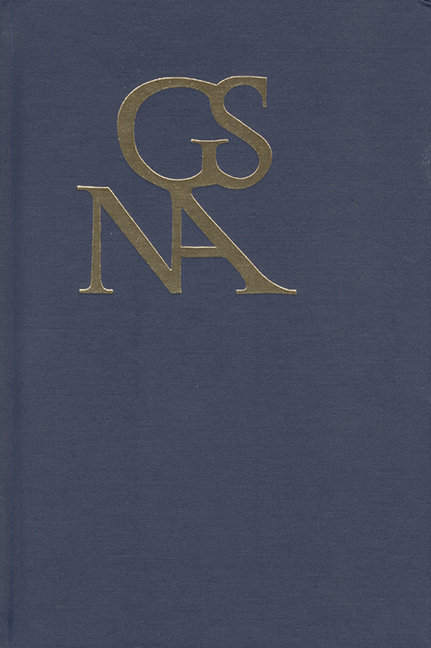Book contents
- Frontmatter
- Contents
- Special Section on What Goethe Heard, edited by Mary Helen Dupree
- What Goethe Heard: Special Section on Hearing and Listening in the Long Eighteenth Century
- Behind Herder's Tympanum: Sound and Physiological Aesthetics, 1800/1900
- Becoming the Listener: Goethe's “Der Fischer”
- Of Barks and Bird Song: Listening in on the Forgotten in Ludwig Tieck's Der blonde Eckbert
- Garden Empire or the Sublime Politics of the Chinese-Gothic Style
- Die Austreibung des Populären: Schillers Bürger-Kritik
- Goethe and the Uncontrollable Business of Appropriative Stage Sequels
- Repetition and Textual Transmission: The Gothic Motif in Goethe's Faust and “Von deutscher Baukunst”
- “Die gewalt'ge Heldenbrust”: Gender and Violence in Goethe's Iphigenie auf Tauris
- Literary Form and International World Order in Goethe: From Iphigenie to Pandora
- Two Gifts from Goethe: Charlotte von Stein's and Charlotte Schiller's Writing Tables
- Goethe's Wilhelm Meister and the Refusal to Grow Up: The Dialectics of Bildung
- “So steh' ich denn hier wehrlos gegen dich?”— Figures of Armament and Disarmament in German Drama before and after the French Revolution
- Goethe, Maimon, and Spinoza's Third Kind of Cognition
- Die Neuvermessung von Lyrik und Prosa in Goethes Novelle
- Book Reviews
Behind Herder's Tympanum: Sound and Physiological Aesthetics, 1800/1900
from Special Section on What Goethe Heard, edited by Mary Helen Dupree
Published online by Cambridge University Press: 16 May 2018
- Frontmatter
- Contents
- Special Section on What Goethe Heard, edited by Mary Helen Dupree
- What Goethe Heard: Special Section on Hearing and Listening in the Long Eighteenth Century
- Behind Herder's Tympanum: Sound and Physiological Aesthetics, 1800/1900
- Becoming the Listener: Goethe's “Der Fischer”
- Of Barks and Bird Song: Listening in on the Forgotten in Ludwig Tieck's Der blonde Eckbert
- Garden Empire or the Sublime Politics of the Chinese-Gothic Style
- Die Austreibung des Populären: Schillers Bürger-Kritik
- Goethe and the Uncontrollable Business of Appropriative Stage Sequels
- Repetition and Textual Transmission: The Gothic Motif in Goethe's Faust and “Von deutscher Baukunst”
- “Die gewalt'ge Heldenbrust”: Gender and Violence in Goethe's Iphigenie auf Tauris
- Literary Form and International World Order in Goethe: From Iphigenie to Pandora
- Two Gifts from Goethe: Charlotte von Stein's and Charlotte Schiller's Writing Tables
- Goethe's Wilhelm Meister and the Refusal to Grow Up: The Dialectics of Bildung
- “So steh' ich denn hier wehrlos gegen dich?”— Figures of Armament and Disarmament in German Drama before and after the French Revolution
- Goethe, Maimon, and Spinoza's Third Kind of Cognition
- Die Neuvermessung von Lyrik und Prosa in Goethes Novelle
- Book Reviews
Summary
IN EARLY 1769, at the age of twenty-five, Johann Gottfried Herder composed the last of his so-called ‘kritische Wälder’ (critical forests), a series of essays responding to the aesthetic theories of contemporaries such as Christian Adolf Klotz, Friedrich Just Riedel and Gotthold Ephraim Lessing. Drawing most extensively on Lessing's foundational media-theoretical work, Laokoon oder über die Grenzen der Mahlerey und Poesie (Laokoon, or the Limits of Painting and Poetry, 1766), the series examined the coevolution of the human sensorium and the historical differentiation of the arts. In contrast to his contemporaries, Herder ascribed particular importance to the sense of hearing and dedicated large sections of his critical forests to explaining the uniqueness of aesthetic experiences mediated by the ear. In order to make his case for hearing, Herder looked beyond the fields of philosophy and art history to the recent work in physiology he had encountered during his brief tenure as a medical student at the University of Königsberg.
Nowhere was this attempt to fuse art history with medical science clearer than in his Viertes Kritisches Wäldchen (Fourth Critical Forest) from 1769, which, according to Herder, aimed at making sense of “[die] innere Physik des Geistes” ([the] inner physics of the mind) or “die Physiologie der Menschlichen Seele” (the physiology of the human soul). Specifically, the essay discussed the nature of sound and aesthetic pleasure with numerous references to the anatomical structure of the ear. In support of the essay's central distinction between ‘sound’ (Schall) and ‘tone’ (Ton), Herder drew readers’ attention to the ear's “Tympanum” (102; tympanum), “Trommelfell” (138; tympanic membrane), “Nervenäste” (105; nerve branches), and “Fasern” (108; fibers).
This foregrounding of the ear's corporeality and its incorporation into a theory of musical aesthetics and poetics was consistent with Herder's broader intellectual project, which aimed to rehabilitate auditory experience against the backdrop of Enlightenment ocularcentrism. While his Viertes Kritisches Wäldchen offered a theory of aesthetic pleasure and the sonic sublime grounded in the physiology of auditory perception, his Abhandlung über den Ursprung der Sprache (Essay on the Origin of Language, 1772) elevated the ear to the status of “erste Lehrmeister der Sprache” (the first language teacher), and characterized the process of language acquisition as an acoustic exchange.
- Type
- Chapter
- Information
- Goethe Yearbook 25Publications of the Goethe Society of North America, pp. 11 - 30Publisher: Boydell & BrewerPrint publication year: 2018



